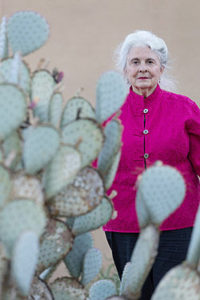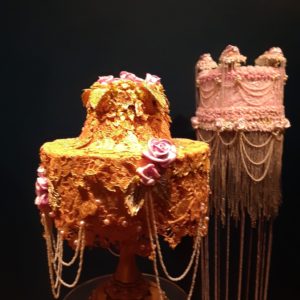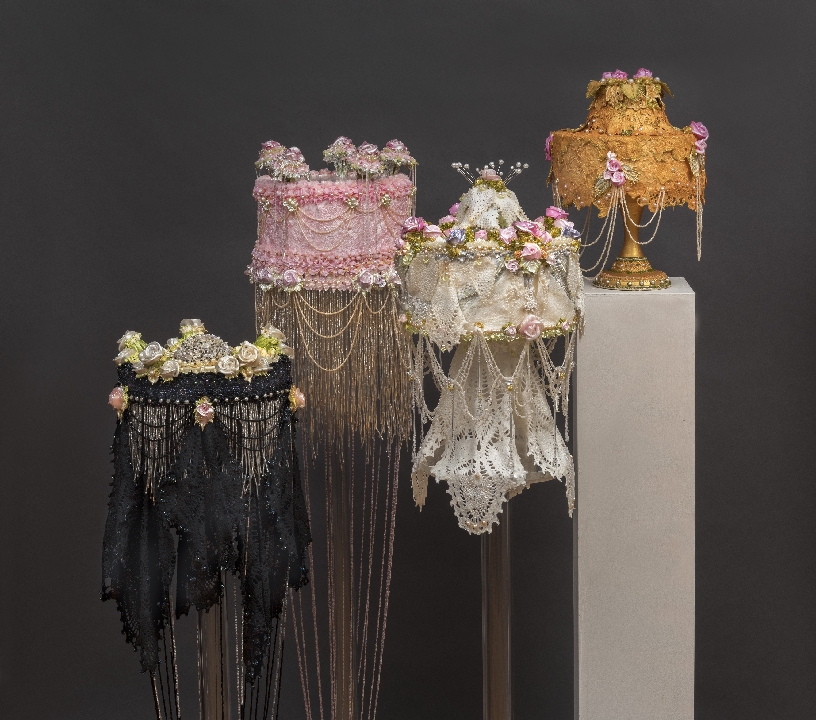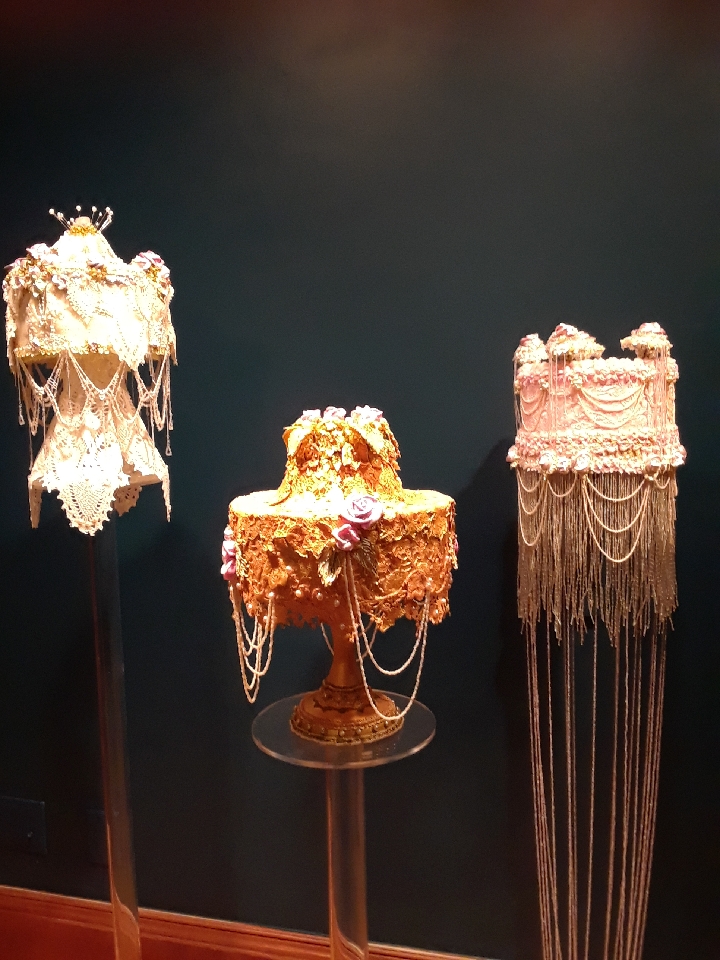As you know I recently started researching, writing and interviewing successful artists in all genres. I guess you might say I am scratching an itch. How do highly accomplished creative men and women feel about their lives and careers mid-life and beyond? What can we learn from the movers and shakers who influenced our culture and continue to do so?
On a beautiful desert morning, as I drove into a wonderfully quirky mobile home park in Rancho Mirage, California, I knew I was going to affirmatively scratch my creative itch. I was about to interview the extremely talented American conceptual artist, painter and sculptor, Pat Lasch (b. 1944)
Lasch was part of the first generation of feminist artists whose work gained prominence in the United States. Her sculptures depict ordinary objects created in unusual ways, often using dried acrylic paint made in pieces and stitched together. The daughter of a pastry chef, many of her works are of intricate wedding cakes and dresses, all made with polymer acrylic paint that she either pours, extrudes or presses into molds.
Lasch has exhibited throughout her career and her work can be found in collections of the Metropolitan Museum of Art, the Smithsonian American Art Museum and the Museum of Modern Art. In 2017 “Journeys of the Heart” was exhibited at the Palm Springs Museum of Art and surveyed 43 years of her work. I hope you enjoy this interview as much as I enjoyed every minute of my visit with the artist. Her honesty and candor were refreshing, and I left the interview honored to have met her.
Lasch: Many teachers along the way encouraged me but Serra and the figurative sculptor, Richard McDermott Miller (1922-2004) who I also took courses from was most encouraging. I went from a very formal training to an Avant-garde way of thinking. Miller felt I had an extraordinary background having been trained in the pastry business with my dad. He had a very similar background, because he was in business with his father who owned a plaster factory. At forty years old he sold the factory and moved to New York where he started showing his artwork. So, Dick really encouraged me to explore myself and Serra encouraged me to expand my world, giving me books to read and new ideas to process. The last tine Serra came to my studio he said “I told you not to do that and you did it anyway, but It’s good!” Although he clearly supported my work, he never came back to my studio and our affair ended.
Lasch: I remember the very talented Lee Krasner had said in an interview that she would plead with Pollack to come into her studio. She never got her due. Likewise, Camille Claudel, the French sculptor and Rodin’s lover who contributed her talent to a lot of Rodin’s work, died in obscurity. That is often what happened to women artists, so I guess you might say I have been lucky. I have always had dealers who believed in me and asked me to show with them.
Lasch: After Serra, I started dating the composer Phillip Glass. He was exotic and brilliant. He spoke fluent Tibetan. It was through Phillip in 1975, that I became involved in Tibetan Buddhism, travelled to India to study with Lama Kalu Rimpoche, and seek audience with the Dali Lama. I was yearning for a spiritual connection after forsaking Catholicism. In the early 1970’s and 1975 I had been working on “tondos”, stretched muslin pieces that had been sewn with thousands of stitches. I made a tiny muslin piece to give to the Lama. He looked at it, turned it over and over and then he blew his nose in it. (Laughs). Although I think he thought it was an embroidered handkerchief, it was certainly a message for me; my first lesson in ego.
Lasch: I did several silent retreats throughout my life; some two or three-month retreats. When my mother died in 1999, I went into almost three months of silence. I attended a Catholic retreat for three weeks and then I went to Spirit Rock, Jack Kornfield’s place and I stayed there for two months. It is recommended that you not go into a three-month retreat right away, rather you should work into it. I started with a weekend retreat and then an eight-day retreat, one with the Jesuits, where I did a short version of the Spiritual Steps of St. Ignatius, which I found to be quite profound. I learned walking meditation from Thich Nhat Hanh, with whom I spent several retreats. Today I practice some form of daily meditation. I find through meditation one loses the boundaries of the body and lives in the present moment where there is no death or birth. As I age, my art and meditation have become the mainstay of my life (with an occasional vodka).
Lasch: Yes, I would like to continue that. I think its important for the mind. This place, in the desert, is the most amazing place. I have become more ordinary here and I like being more ordinary. When I was young, I wanted to be a star. Now, I don’t care for the limelight as much. I like the quiet of the desert and I can focus here. I could just make hundreds of my small cake sculptures, so that my daughter would always have them when I am gone. I have and cherish all the hand-crocheted blankets my mom made for me before her death.
Lasch: My work has always been very personal. I remember Serra saying to me, “Art isn’t psychology, it’s not about that”. But I disagree. For me it was about my internal feelings, my very personal feelings. My work is very intricate, and it’s never finished all at once. It must go through numerous stages of drying time. Therefore, it takes time to complete. My work puts me into a place where nothing else matters, because I need to be in the moment. When I’m squeezing paint through a wax paper one, I can’t be thinking of other things. I need to be sensitive to the feel of what’s happening at that moment. I find the work, works on me as much as I work on the work. It is a back and forth like any relationship. I don’t know where many of my ideas come from, but they seem to appear in the moments between wake and sleep. One of the things I have studied is the Enneagram (a model of the human psyche that studies nine personality types). Artists generally function in different ways; some function through their brain, through logic and analysis like Mondrian and some function from their gut like De Kooning, and still other through their heart like Frieda Kahlo. So, one can sometimes use more heart or more brain. I believe that in my case, I use my heart and my intellect.
Lasch: Yes, and I would add that in a study of mental illness and the creative brain, the artist is able to allow the mind to go to a creative space, but knows when it is time to pull back, whereas the mentally ill person does not have the capability to pull back.
Lasch: My best day is when I get up, have a cup of tea and go straight to my work bench. Tea-time is generally a tea meditation; my quiet time and then I will work for maybe two hours, unless I am piecing things together, when I might work all day.
Lasch: Well, yes, of course…I’m 74! Recently I was shaken by a fall, crushing my left and hand and breaking two ribs. Thank god I had a good surgeon! I was in the hospital for 2 ½ weeks and in rehab as well. I’m still in some pain and that can be an eye-opening experience. There is a plate in my wrist making it hard to do some of the things I normally do, such as open jars of paint, but I’m on my way. So, I am a survivor…yes, I am!
I have also gone through some serious depressions in my life and I use my mindfulness as a coping mechanism, or I go to the mountains where I built a home. It has a pond where I swim and sometimes, I live and work entirely off the grid, where I pump my own water.
Lasch: I have thought about it, but not in terms of not “wanting” to work. I have had five eye surgeries due to something called low tension glaucoma, so I have lost some vision. When I realized how this disease snuck up on me, I started visualizing where I might be if I lost my sight entirely. I don’t know if I could keep everything up. You see, I live in three places all the time. I live in New York City and I have a home (that I built myself in the 40’s) in the mountains, with an upper cabin and lower studio where I work, swim, and hang with frogs and dragon flies. I also live here in the desert in the winters. But I know many women artists who worked to the end, so who knows.
Lasch: Well, I have said in a past interview, if you see a gook-looking guy walk in a room, look BUT, turn around and walk the other way (Laughs).
Lasch: To the young artist, Pat Lasch, I would say, be kind and stay focused. Don’t let the press get to you in any way, good or bad. I am who I am. You must be who are, and you must honor that.

Photo by Jamie Kowal




Beyond being an exceptional talent, Pat Lasch has led an exciting life and is a wonderful storyteller. As an artist, she continues to create and push boundaries. I look forward to visiting Los Angeles in October when Lasch will be part of an upcoming fall show, “With Pleasure: Pattern and Decoration in American Art 1972-1985” at the Museum of Contemporary Art (MOCA) on Grand Avenue, October 27, 2019-May 11, 2020.
